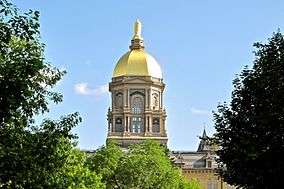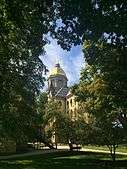Main Building (University of Notre Dame)
| Main Administration Building | |
|---|---|
 Golden Dome of the Main Administration Building | |
| Alternative names | Main Building, the Golden Dome |
| General information | |
| Status | Used as administration and class building |
| Architectural style | Collegiate Gothic |
| Town or city | Notre Dame, Indiana |
| Country | United States |
| Coordinates | 41°42′11″N 86°14′20″W / 41.703109°N 86.238938°W |
| Construction started | May 17, 1879 |
| Completed | September 1, 1879 |
| Client | University of Notre Dame |
| Owner | The University of Notre Dame |
| Height | 187 ft |
| Design and construction | |
| Architect | W.J. Edbrooke |
| Website | |
| www.dome.nd.edu | |
|
Administration Building | |
 | |
| Location | Notre Dame, Indiana |
| Coordinates | 41°42′8.2764″N 86°14′17.4516″W / 41.702299000°N 86.238181000°WCoordinates: 41°42′8.2764″N 86°14′17.4516″W / 41.702299000°N 86.238181000°W |
| Built | 1879[1] |
| Architect | Willoughby J. Edbrooke [1] |
| Architectural style | Collegiate Gothic |
| Part of | University of Notre Dame: Main and North Quadrangles (#78000053) |
| Added to NRHP | May 23, 1978 |
The University of Notre Dame's Main Administration Building (known as the Main Building or the "Golden Dome") houses various administrative offices, including the Office of the President.[2] Atop of the building stands the Golden Dome, the most recognizable landmark of the University.[3][4]
History
Previous main buildings
The first main building was started on August 28, 1843, shortly after the architect Mr. Marsile arrived on campus on the 24th. it was complete by the fall of 1844. It was a brick building, 4 1/2 story high with a small cupola (not yet a dome) with a bell in it, in French style.
Construction of the second Main Building, which replaced the first, began in 1864 and was completed in 1865. It was to be 160 feet long, 80 feet wide, and 90 feet high; it was six stories high and had a dome at the top. The architect was Mr. Thomas from Chicago, and most of the workers who built it were brothers of the Congregation of Holy Cross. Classes were taught on the third floor, while the fourth and fifth floors were dormitories.
Fire of 1879
The building stood for 14 years before being destroyed by a great fire on April 23, 1879. About eleven in the morning on Wednesday morning, 23 April 1879, smoke and flames could be seen rising from the roof of the Main Building. The causes of the fire were impossible to ascertain. Workmen had been working on repairs on the roof until around 10 o'clock, and the fire might have started due to the dry timber on the roof. The fire was first spotted from the minim's courtyard, and soon word of the event spread to the rest of the students and faculty. Early attempts at putting out the fire were made, with lines of people passing buckets of waters towards the roof of the building. Water was forced into the great tanks on the roof by steam pressure. Despite these efforts, the fire had spread to the entire roof and quickly consumed the upper floors. The South Bend Fire Department was not able to arrive in time to save the main building, because of the long time needed to round up the volunteer firemen and set up the machines. The supports of the dome burned away and the statue went crashing below in a billow of sparks and flame, and even the most courageous abandoned the hope of saving the building and focused on rescuing whatever valuable effects might be carried out of the burning building. In the zeal to save precious objects students threw many of the valuables from the windows, yet despite the well-intentioned effort, almost all of these were lost in crashing on the ground. This was especially true for many of the most precious books and manuscripts.[5]
The fire consumed the building in three hours. The building contained most of the school’s educational and administrative activities, refectories, and student and faculty living quarters. Within three hours, the Main Building had been destroyed. The flames also consumed The Saint Francis Old Men’s Home, the Infirmary, the Minims Hall (the grade school program), and the Music Hall. Fortunately, fire fighters from South Bend arrived in time help save the kitchen, steam house, printing office, Presbytery, Washington hall and Sacred Heart Church. Additionally, the lack of strong winds prevented the fire from spreading to these other buildings. Many students, nuns and faculty narrowly escaped serious injury or death while they tried to save the Main Building’s contents as parts of the structure came tumbling down around them.[6]
At three o'clock Father William Corby, the University president, met with his wisest assistants and they determined that nothing could be done but close the college for the year. An hour after he communicated the decision to the students assembled in the church. Students did not want to leave, but Fr. Corby made it clear that the University could not provide any accommodations. Hence, the students were sent home for the semester. The loss was estimated at $200,000 and only $45,000 was recovered from the insurance. It was a terrible blow, for in three hours was wiped out the result of thirty-five years of hard, grueling sacrifice.[7]
Father Edward Sorin, now the superior-general of the Order of the Holy Cross, had left on a trip to Europe two days prior to the fire. He immediately returned to campus after the fire to find much of his school in ruins. He vowed to the students and faculty to rebuild the school in time for the fall semester. Condolences started to pour into the school immediately, many of them published in subsequent issues of the student weekly magazine Scholastic.
Current building
University founder Rev. Edward Sorin and the president at the time Rev. William Corby immediately planned for the rebuilding of the structure that had housed virtually the entire University. Donations for the rebuilding of the college came from alumni, people of Saint Mary's College, South Bend, and Chicago.

"By all means we must bring upon these new foundations the richest blessings of Heaven, that the grand edifice we contemplate erecting may remain for ages to come a monument to Catholicism, and a stronghold which no destructive element can ever shake on its basis or bring down again from its majestic stand.[8]
The University took action by selecting a new design by Willoughby J. Edbrooke, who drew the new plans by May 10th. Architect Edbrooke, Brother Charles Borromeo (Patrick) Harding, C.S.C, and mathematics professor William Ivers marked off the dimensions of the construction on the day of the groundbreaking ceremony, May 17th, and the first stone for the foundation was laid on the 19th. Railcars full of bricks arrived continuously to town and were brought to campus in a steady stream of wagons. By May 31, twenty-six stonemasons and bricklayers were working with their support crews on the walls of the new building. The construction required about 300 veteran tradesmen, including 156 skilled stonemasons and bricklayers. This exceeded the number of experienced workers in the South Bend area, and was also scarce in Chicago because of the rebuilding effort due to the great fire in October 1871. Hence, skilled workmen were brought into South Bend from great distances.
The construction was very rapid due to the zeal of workers and volunteers. By June 21, the first story was completed, and by June 28, they completed the second. The Fourth of July saw the completion of the third. The building was completed before the fall semester of 1879. Fifty-six bricklayers and 4,350,000 bricks were necessary to complete it, and once finished it stood 187 feet tall. The building also required 300 tons of cut limestone. [9] The halls were wide and it was considered hygenic, since they had installed a ventilating system unequalled in any public building in America at the time.
The Golden Dome was the last thing to be finished, with the iron framework, the panels and the columns supporting the dome, being added during the summer of 1882 and the dome itself was finished in September. The statue of Mary was hoisted in October. It was a gift from the sisters of adjacent Saint Mary's College, Notre Dame's sister school.[10] It was gilded in 1886 and crowned with a 19 feet tall statue of "Our Mother", the namesake of the university. The statue was designed and furnished by the girls of the nearby Saint Mary's College; it replicates the pose of the statue of Mary on the Column of the Immaculate Conception in Piazza di Spagna in Rome, erected under Pius IX. It was designed by Chicago artist Giovanni Meli.[11]
Architecure
The building's style has been described as follows:
Edbrooke called the finished product ‘modern Gothic’; a later University Architect, Francis Kervick, referred to the Victorian monument as ‘an eclectic and somewhat naïve combination of pointed windows, medieval moldings and classical columns.’ Others have dubbed the buildings’ riot of turrets, gables, angles, corners, and oversized dome and rotunda as pure and simple ‘modern Sorin. [12]
Interior
The halls are decorated by portraits of the presidents of the university. The lower level hosts a gallery dedicated to the Laetare Medal awardees and the Wall of Honor adorned by plaques dedicated to notable people awarded for their service to the University. The building also houses the Columbus Murals, a group of large paintings by Italian painter and Notre Dame professor Luigi Gregori, depicting the discovery of the New World by Christopher Columbus. Gregori also painted with figures representing Religion, Philosophy, Science, History, Fame, Poetry and Music the interior of the Golden Dome, the University's most recognizable landmark.[3][13]
Usage and traditions
The building is the location of many administrative offices of the university including that of the President, Office of Admissions, and various other offices and services of the University. Additionally, it has classrooms and meeting rooms.
In campus lore, if a student ascended the front steps of the Main Building before graduation, that student was doomed never to graduate. This legend stems from traditionalist smoking rituals. Students were not deemed worthy to climb the steps and smoke with their professors until they received their degrees and were educational equals.[14]
Gallery
 Main building seen from Main Quad
Main building seen from Main Quad The Main Building in winter
The Main Building in winter The Dome seen from Cavanaugh Hall
The Dome seen from Cavanaugh Hall Close up of the Golden Dome
Close up of the Golden Dome Golden Dome at night
Golden Dome at night Close up of the Statue
Close up of the Statue- Interior of the Golden Dome
References
- 1 2 "Official Building Inventory" (PDF). Facilities Design and Operations. University of Notre Dame. 1 October 2015. Retrieved 11 November 2015.
- ↑ University of Notre Dame, Sights and Sounds: Main Building
- 1 2 "Romancing the Golden Dome". tribunedigital-chicagotribune.
- ↑ http://news.nd.edu/news/7572-golden-dome-to-be-regilded-for-the-tenth-time/
- ↑ http://www.archives.nd.edu/Scholastic/VOL_0012/VOL_0012_ISSUE_0034.pdf
- ↑ http://www.archives.nd.edu/Scholastic/VOL_0012/VOL_0012_ISSUE_0034.pdf
- ↑ http://www.archives.nd.edu/Scholastic/VOL_0012/VOL_0012_ISSUE_0035.pdf
- ↑ "Circular Letter No. 96 from Fr. Sorin to the Holy Cross Community" (PDF). archives.nd.edu. May 23, 1879.
- ↑ "Notre Dame: Main Building".
- ↑ University of Notre Dame, Sights and Sounds: Golden Dome
- ↑ "Notre Dame -- 100 Years: Chapter XIII".
- ↑ Schlereth, Thomas (1976). The University of Notre Dame: A Portrait of Its History and Campus. Notre Dame, IN: University of Notre Dame Press. pp. 55–9.
- ↑ "Administration Building, University of Notre Dame".
- ↑ Schlereth, Thomas, A Dome of Learning
External sources
- Notre Dame One hundred years
- Campus Tour
- Notre Dame Archives
- Live Webcam
- Article on the Chicago Tribune
- Article on ESPN
